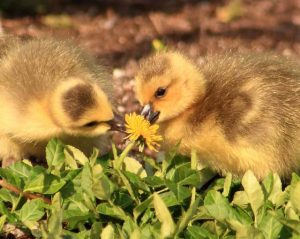Experts warn about long-term problems of feeding wildlife
Chronicle Media — April 23, 2017
Feeding ducks at local ponds seems like fun and helpful, but it can cause long-term damage to not only the ducks but to the ecosystem. (Photo courtesy of McHenry Co. Conservation Dist.)
How many of you have gone to feed the ducks at a local park or pond near your home?
Whoever it was that took you to the pond to feed the ducks more than likely took a bag of white bread or bread heels, and those ducks went nuts for that bread.
However, have you stopped to think about what feeding wildlife does to wildlife? I am not talking about putting a bird feeder out in the winter to help support birds that live here year-round; this has some very positive effects on these birds.
However, when not done properly there are many disadvantages to feeding wildlife.
- It creates a dependence on humans. Feeding wildlife creates a dependence on humans for food. We have all been in a state or national park and seen the signs that say “Please Do Not Feed the Wildlife” — there is a reason for this.
When we feed wildlife, particularly when there are young individuals involved, the animals can lose their ability to forage effectively, or they do not learn to forage.
- It can create health problems in wildlife. The foods that we commonly feed wildlife are things that lack the necessary nutrients for wildlife.
In the case of ducks, geese, and other waterfowl the lack of sufficient nutrients can cause joint issues in the wings that can severely restrict their flight or can stop them from flying at all. This makes them easy prey for predators and keeps them from being able to migrate.
- It can keep wildlife from migrating. Having a stable ready food supply that is available throughout the year can indicate to some species that would usually migrate, that they do not need to migrate.
It takes a lot of energy to migrate, and if they do not have to, they might stay put. This puts additional, unnecessary stress on the species that would ordinarily stay.

Feeding wildlife creates a dependence on humans for food, especially for young animals who can lose their ability to forage effectively, or they do not learn to forage at all. (Photo courtesy of U of Illinois Extension)
It also might delay migration in some animals, which puts extra stress on the individuals that are moving through an area on their normal migration. This makes the migration process much more difficult.
- It can cause a loss of fear of humans. It is important that animals keep a natural fear of humans. If a fear of humans is lost, animals will approach humans and can become aggressive when food is not available. This can increase animal attacks and the spread of disease.
- It can destroy habitats and cause loss of biodiversity. When we feed animals, they tend to congregate in the “feeding” areas. This can create a population that cannot support itself in certain areas. This causes the over browsing of plants in an area and can restrict the spread of seeds, or if a plant is under too much stress, they may not set seeds at all.
This affects not only the plants but also the insects that need the flowers or leaves. The higher populations of animals can also lead to aggressive behavior in animals as they compete for resources and can lead to starvation and very poor health in animals in the area.
Feeding wildlife is a fun activity on the surface, but when you feed animals, you need to think about what the consequences are for your fun. Think before you go out and feed the ducks. Take young children out to admire the wildlife and teach them that they are to be enjoyed from a distance.
If you have any questions about Natural Resources, contact Jason Haupt (jdhaupt@illinois.edu).
— Experts warn about long-term problems of feeding wildlife —







